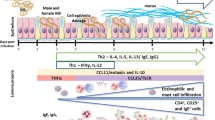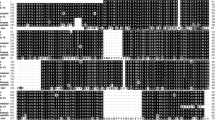Abstract
Trichinella spiralis actively passes through the epithelial cells of the intestinal mucosa but morphologically, these cells do not manifest apparent damage. The possible activation of apoptotic mechanisms in the small intestine mucosa after infection with larvae and adults of Trichinella spiralis was explored by immunohistochemistry. Sporadic individual cells of normal intestinal epithelium showed activation of caspase-3, increased expression AIF, or Bax. The larval stage of intestinal trichinellosis was characterized by distortion of cells on the villus tips that were strongly reactive to caspase-3, Bax, and survivin antibodies. There was a transient loss of the survivin expression on the brush border of the epithelial cells at 15-h post infection, which reappeared on the fifth day. Bcl-2 changed its normal apical distribution and re-localized to the basal part of the epithelial cells. No significant changes of expression of the selected apoptosis-related proteins were observed in the intestinal epithelial cells immediately surrounding the worms. The presence of Trichinella affects intestinal epithelial cells, but unlike in muscle cells, invading them does not initiate apoptotic factors activation.


Similar content being viewed by others
References
Babál P, Milcheva R, Petkova S, Janega P, Hurniková Z (2011) Apoptosis as the adaptation mechanism in survival of Trichinella spiralis in the host. Parasitol Res 109:997–1002
Boonmars T, Wu Z, Nagano I, Takahashi Y (2004) Expression of apoptosis-related factors in muscles infected with Trichinella spiralis. Parasitology 128:323–332
Bürkle A (2005) Poly (ADP-ribose). The most elaborate metabolite of NAD. FEBS 272:4567–4589
Butcher BA, Gagliardo LF, ManWarren T, Appleton JA (2000) Larvae-induced plasma membrane wounds and glycoprotein deposition are insufficient for Trichinella spiralis invasion of epithelial cells. Mol Biochem Parasitol 107:207–218
Capó V, Despommier DD (1996) Clinical aspects of infection with Trichinella spp. Clin Microbiol Rev 9:47–54
Chen L, Rao KVN, He Y, Ramaswamy K (2002) Skin-stage schistosomula of Schistosoma mansoni produces an apoptosis-inducing factor that can cause apoptosis of T cells. J Biol Chem 277(37):34329–34335
Cheung ECC, Melanson-Drapeau L, Gregan SP, Vanderluit JL, Ferguson KL, McIntosh WC, Park DS, Bennett SAL, Slack RS (2005) Apoptosis-inducing factor is a key factor in neuronal cell death propagated by BAX-dependent and BAX-independent mechanisms. J Neurosci 25:1324–1334
Chow SC, Brown A, Pritchard D (2000) The human hookworm pathogen Necator americanus induces apoptosis in T lymphocytes. Parasite Immunol 22(1):21–29
Despommier DD (1998) How does Trichinella make itself at home? Parasitol Today 14:318–323
Despommier DD, Sukhdeo M, Meerovitch E (1978) Trichinella spiralis: site selection by the larva during the enteral phase of infection in mice. Exp Parasitol 44:209–215
Dunn IJ, Wright KA (1985) Cell injury caused by Trichinella spiralis in the mucosal epithelium of B10A mice. J Parasitol 71(6):757–766
Fadeel B, Orrenius S (2005) Apoptosis: a basic biological phenomenon with wide-ranging implications in human disease. J Int Med 258:479–517
Fujise T, Iwakiri R, Wu B, Amemori S, Kakimoto T, Yokoyama F, Sakata Y, Tsunada S, Fujimoto K (2006) Apoptotic pathway in the rat small intestinal mucosa is different between fasting and ischemia-reperfusion. Am J Physiol Gastrointest Liver Physiol 291:G110–G116
Gallego MA, Joseph B, Hemstrom TH, Tamiji S, Mortier L, Kroemer G, Formstecher P, Zhivotovsky B, Marchetti P (2004) Apoptosis-inducing factor determines the chemiresistance of non-small-cell lung carcinomas. Oncogene 23:6282–6291
Goldstein J, Waterhouse N, Juin P, Evan G, Green D (2000) The coordinate release of cytochrome c during apoptosis is rapid, complete and kinetically invariant. Nat Cell Biol 2:156–162
Gregan SP, Fortin A, MacLaurin JG, Callaghan SM, Cecconi F, Yu SW, Dawson TM, Dawson VL, Park DS, Kroemer G, Slack RS (2002) Apoptosis-inducing factor is involved in the regulation of caspase-independent neuronal cell death. JCB 158:507–517
Gupta S (2003) Molecular signaling in death receptor and mitochondrial pathways of apoptosis (Review). Int J Oncol 22:15–20
Hong SJ, Dawson TM, Dawson VL (2004) Nuclear and mitochondrial conversations in cell death: PARP-1 and AIF signaling. Trends Pharm Sci 25:259–264
Hsu YT, Wolter KG, Youle RJ (1997) Cytosol-to-membrane redistribution of BAX and Bcl-XL during apoptosis. Proc Natl Acad Sci U S A 94:3668–3672
Hyoh Y, Ishizaka S, Horii T, Fujiwara A, Tegoshi T, Yamada M, Arizono N (2002) Activation of caspases in intestinal villus epithelial cells of normal and nematode infected rats. Gut 50:71–77
Jasmer DP, Yao S, Vassilatis D, Despommier D, Neary SM (1994) Failure to detect Trichinella spiralis p43 in isolated host nuclei and in irradiated larvae of infected muscle cells which express the infected cell phenotype. Mol Biol Parasitol 67:225–234
Karmańska K, Houszka M, Piekarska J (2000) The phenomenon of apoptosis in the course of experimental trichinellosis in mice. Wiad Parasitol 46:111–115
Kelman Z (1997) PCNA: structure, functions, and interactions. Oncogene 14:629–640
Ko RC, Fan L, Lee DL, Compton H (1994) Changes in host muscles induced by excretory/secretory products of larval Trichinella spiralis and Trichinella pseudospiralis. Parisitology 108:195–205
Kroemer G, Galluzzi L, Brenner K (2007) Mitochondrial membrane permeabilization in cell death. Physiol Res 87:99–163
Kuroda A, Uchikawa R, Matsuda S, Yamada M, Tegoshi T, Arizono N (2002) Up-regulation of Fas (CD95) and induction of apoptosis in intestinal epithelial cells by nematode-derived molecules. Infect Immun 70(8):4002–4008
Larsh JE, Race GJ (1954) A histopathological study of the anterior small intestine of immunized and non-immunized mice infected with Trichinella spiralis. J Inf Dis 94:262–272
Larsh JE, Race GJ (1975) Allergic inflammation as a hypothesis for the expulsion of worms from tissues: a review. Exp Parasitol 37:251–266
Lechler P, Wu X, Bernhardt W, Campean V, Gastiger S, Hackenbeck T, Klanke B, Weidemann A, Warnecke C, Amann K, Engehausen D, Willam C, Eckardt KU, Rödel F, Wiesener MS (2007) The tumor gene surviving is highly expressed in adult renal tubular cells. Implications for a pathophysiological role in the kidney. Am J Pathol 171(5):1483–1498
Lemasters JJ, Nieminen AJ, Qian T, Trost LS, Elmore SP, Nishimira Y, Crowe RA, Cascio WE, Bradham CA, Brenner DA, Herman B (1998) The mitochondrial permeability transition in cell death: a common mechanism in necrosis, apoptosis and autophagy. Biochim Biophys Acta 1366:177–196
Leung RKM, Ko RC (1997) In vitro effects of Trichinella spiralis on muscle cells. J Helminthol 71:113–118
Li CKF, Chung YYY, Ko RC (1999) The distribution of excretory/secretory antigens during the muscle phase of Trichinella spiralis and T. pseudospiralis infections. Parasitol Res 85:993–998
Loeffler M, Daugas E, Susin SA, Zamzami N, Metivier D, Nieminen AL, Brothers G, Penninger JM, Kroemer G (2001) Dominant cell death induction by extramitochondrially targeted apoptosis-inducing factor. FASEB 15:758–767
ManWarren T, Gagliardo L, Geyer J, McVay C, Pearce-Kelling S, Appleton J (1997) Invasion of intestinal epithelia in vitro by the parasitic nematode Trichinella spiralis. Infect Immun 65(11):4806–4812
Navone F, Jahn R, Di Gioia G, Stukenbrok H, Greengard P, De Camilli P (1986) Protein p38: an integral membrane protein specific for small vesicles of neurons and neuroendocrine cells. J Cell Biol 103:2511–2527
Nguyen M, Millar DG, Yong VW, Korsmeyer SJ, Shore GC (1993) Targeting of Bcl-2 to the mitochondrial outer membrane by a COOH-terminal signal anchor sequence. J Biol Chem 268(34):25265–25268
O’Connell KM, Rogan MT (2000) Apoptosis in human Jurkat T cell after culture with live Taenia crassiceps cysticerci in vitro. Parasitology 120:649–655
O’Driscoll L, Linchan R, Clynes M (2003) Survivin: role in normal cells and in pathological conditions. Curr Cancer Drug Targets 3:131–152
Piekarska J, Michalski A, Szczypka M, Obmińska-Murkowicz B (2009) Trichinella spiralis: effect of thymus factor X on apoptosis and necrosis in mice. Exp Parasitol 123:128–133
Ramachandran A, Madesh M, Balasumramanian KA (2000) Apoptosis in the intestinal epithelium: its relevance in normal and pathophysiological conditions. J Gastroenterol Hepatol 15:109–120
Susin SA, Daugas E, Ravagnan L, Samejima K, Zamzami N, Loeffler M, Constantini P, Ferri KF, Irinopoulou T, Prévost MC, Brothers G, Mak TW, Penninger J, Earnshaw WC, Kroemer G (2000) Two distinct pathways leading to nuclear apoptosis. J Exp Med 192:571–579
van Wijk SJL, Hageman GJ (2005) Poly (ADP-ribose) polymerase-1 mediated caspase-independent cell death after ischemia/reperfusion. Free Rad Biol Med 39:81–90
Vassilatis DK, Polvere RI, Despommier DD, Gold AM, Van der Ploeg LHT (1996) Developmental expression of a 43-kDa secreted glycoprotein from Trichinella spiralis. Mol Biochem Parasitol 78:13–23
Whright KA, Weidman E, Hong H (1987) The distribution of cells killed by Trichinella spiralis in the mucosal epithelium of two strains of mice. J Parasitol 73(5):935–939
Wisnewski N, McNeil M, Grieve RB, Wassonm DL (1993) Characterization of novel fucosyl- and tyvelosyl-containing glycoconjugates from Trichinella spiralis muscle stage larvae. Mol Biochem Parasitol 61:25–36
Wright KA (1979) Trichinella spiralis: an intracellular parasite in the intestinal phase. J Parasitol 65(3):441–445
Wu Z, Nagano T, Boonmars T, Takahashi Y (2005) Tumor necrosis factor receptor-mediated apoptosis in Trichinella spiralis-infected muscle cells. Parasitology 131:373–381
Yu SW, Wang H, Dawson TM, Dawson VL (2003) Poly (ADP-ribose) polymerase-1 and apoptosis inducing factor in neurotoxicity. Neurobiol Dis 14:303–317
Acknowledgments
The authors express sincere gratitude to Mrs. Emilia Klincová for her excellent technical work. This work was, in part, supported by grant VEGA 2/0011/12 and as the result of the project implementation: “TRANSMED 2”, ITMS: 26240120030, supported by the Research and Development Operational Programme funded by the European Regional Development Fund.
Author information
Authors and Affiliations
Corresponding author
Rights and permissions
About this article
Cite this article
Milcheva, R., Petkova, S., Hurniková, Z. et al. The occupation of intestinal epithelium by Trichinella spiralis in BALB/C mice is not associated with local manifestation of apoptosis related factors. Parasitol Res 112, 3917–3924 (2013). https://doi.org/10.1007/s00436-013-3582-1
Received:
Accepted:
Published:
Issue Date:
DOI: https://doi.org/10.1007/s00436-013-3582-1




